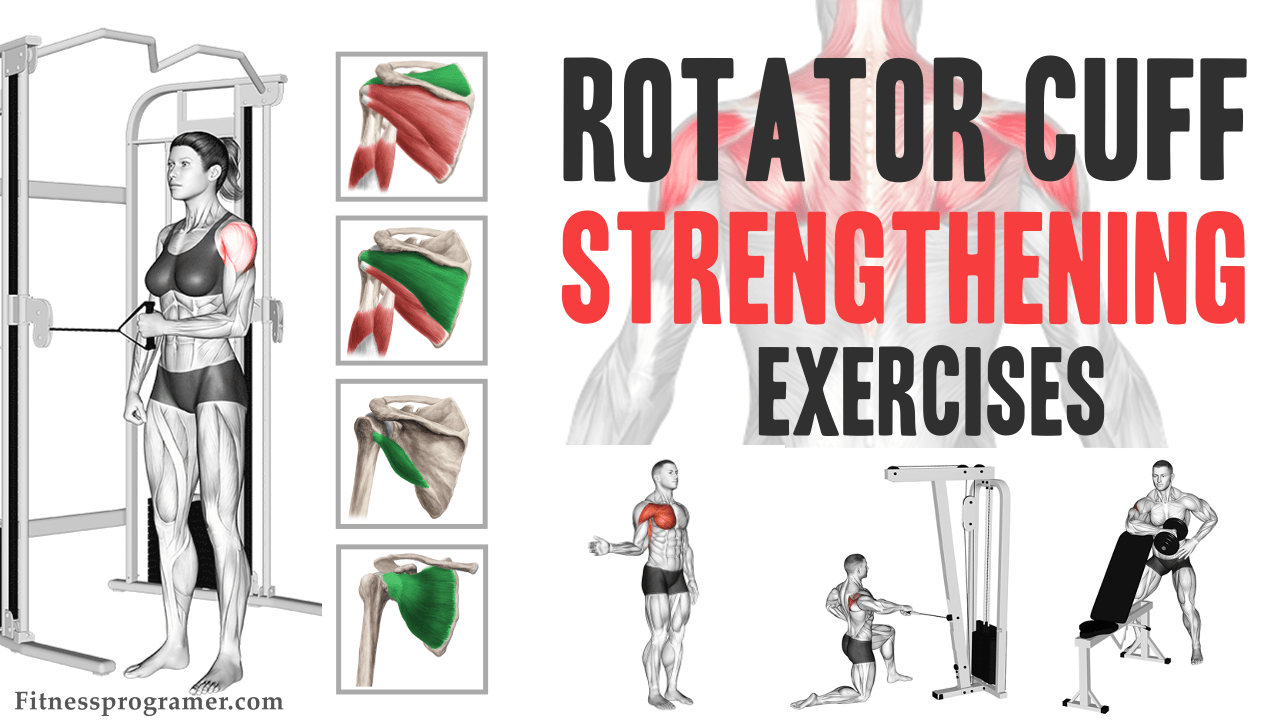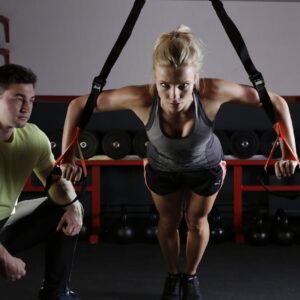Contents
Strengthening the rotator cuff muscles helps maintain shoulder health, prevent injuries, and improve overall shoulder function. For this reason, rotator cuff exercises are the most important shoulder exercises that should be done regularly.
There are many different exercises for strengthening the rotator cuff, and you can perform them with various types of equipment, such as dumbbells, cables, or resistance bands.
If you are healthy and have no pain but want to strengthen your rotator cuff, try some of the exercises on this page. It is recommended to consult with a healthcare professional before starting any exercise program, especially if you have a history of shoulder problems or injuries.
First, let’s examine what the rotator cuff is and its functions, and then we will discuss effective exercises to strengthen it.
Understanding the Rotator Cuff
The rotator cuff is a group of muscles and tendons that surround and support the shoulder joint. It consists of four muscles: the supraspinatus, infraspinatus, teres minor, and subscapularis.
These muscles work together to stabilize the shoulder joint, allowing the arm to move. The rotator cuff also helps to lift and rotate the arm, and it plays a critical role in overhead movements.
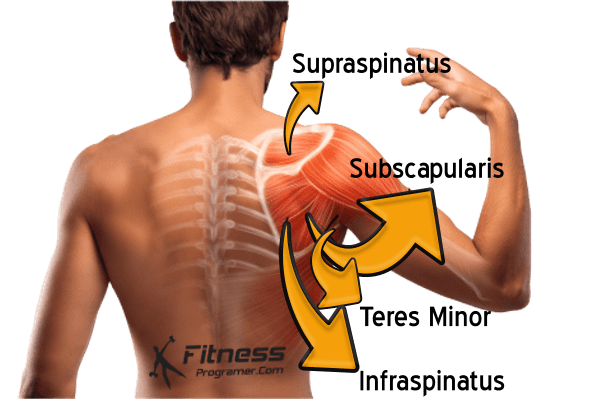
4 Rotator Cuff Muscle and Functions
The rotator cuff muscles allow for movement of the arm in various directions, including abduction, adduction, internal rotation, and external rotation. The rotator cuffs work in conjunction with other muscles of the shoulder to support the movement of the arm and maintain stability of the shoulder joint. (Learn more about shoulder joint movements.)
The functions of the rotator cuff muscles include:
1- Supraspinatus
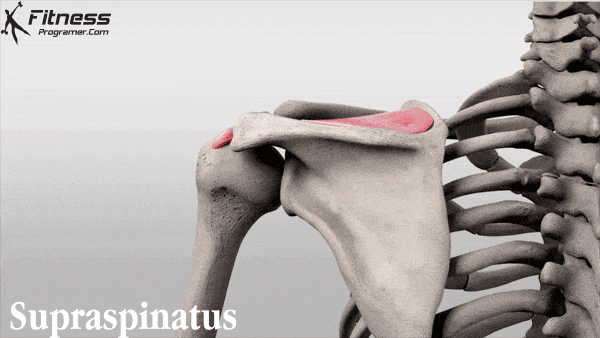
It is above the spine of the scapula (shoulder blade). It pulls the arm out to the side and works with the other muscles to stabilize the shoulder. It is the deltoid that makes the movement, and the supraspinatus helps it by initiating the movement. It is responsible for initiating the abduction movement (first 15 degrees) of the arm.
2- Infraspinatus
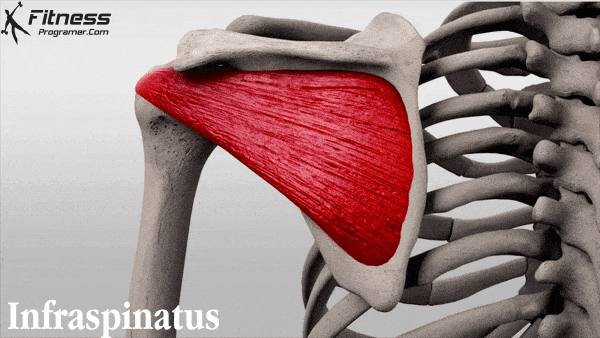
Positioned below the spine of the scapula, the infraspinatus is responsible for external rotation of the shoulder. It collaborates with the teres minor to produce this movement and contributes to overall shoulder stability. Strengthening the infraspinatus is often essential in rehabilitating shoulder injuries.
3- Teres Minor
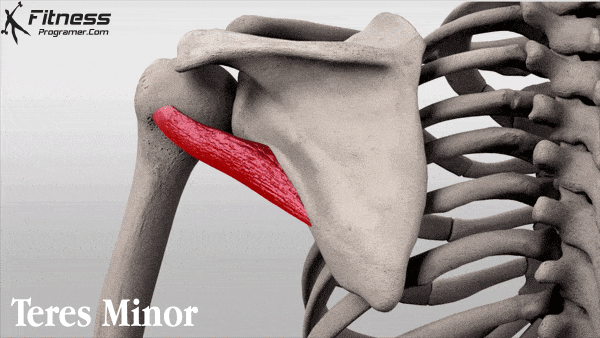
The teres minor is a small muscle that starts on the outside of the shoulder blade just below the infraspinatus. It helps the infraspinatus to turn the shoulder out to the side and helps to keep the shoulder stable.
4- Subscapularis
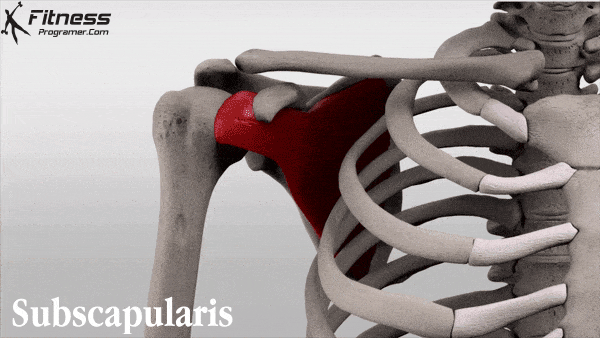
The subscapularis is a unique muscle because it is the only one of the 4 that is located on the front of the shoulder. Since it is on the front of the shoulder blade it rotates the shoulder inwards (internal rotation). Internal rotation exercises are just as important as external rotation exercises.
Main causes of rotator cuff pain
While there are several factors that can contribute to rotator cuff pain, the five main causes are:
- Trauma: Rotator cuff injuries can be caused by a sudden trauma or injury to the shoulder, such as a fall, a blow to the shoulder, or a car accident.
- Overuse: Repetitive overhead movements or frequent use of the shoulder joint, such as in sports or manual labor, can cause wear and tear on the rotator cuff tendons, leading to pain and injury.
- Aging: As we age, the tendons in the rotator cuff can become weaker and more prone to injury or tears.
- Poor posture: Poor posture, especially when sitting or standing for extended periods, can cause the muscles and tendons in the shoulder joint to become tight and weak, increasing the risk of injury.
- Genetics: Some individuals may be more genetically predisposed to rotator cuff injuries, due to variations in the structure or shape of the shoulder joint.
It is important to address the underlying cause of rotator cuff pain in order to prevent further damage and promote healing. Treatment options may include physical therapy, medications, rest, or in severe cases, surgery.
Symptoms
The symptoms of rotator cuff pain can vary depending on the severity of the injury, but some common symptoms include:
- Pain in the shoulder or upper arm: The pain may be sharp or dull and may worsen when you move your arm.
- Weakness in the shoulder: You may have difficulty lifting objects or performing tasks that require you to raise your arm above your head.
- Limited range of motion: You may find it difficult to move your arm in certain directions, such as reaching behind your back.
- Clicking or popping sounds: You may hear clicking or popping sounds when you move your arm.
Why should we strengthen the rotator cuffs?
Strengthening the rotator cuff muscles is important for several reasons:
- Shoulder stability: The rotator cuff muscles play an important role in stabilizing the shoulder joint, especially during overhead movements. Weakness in these muscles can lead to instability and an increased risk of shoulder injuries.
- Injury prevention: Strengthening the rotator cuff muscles can help prevent injuries, particularly for athletes and those who engage in repetitive overhead motions such as throwing a ball or lifting weights.
- Rehabilitation: For individuals who have suffered a rotator cuff injury or undergone surgery, rotator cuff strengthening exercises are a crucial part of the rehabilitation process. These exercises can help restore strength, mobility, and function to the shoulder joint.
- Improved performance: Strong rotator cuff muscles can improve overall shoulder function, allowing for better performance in sports and other activities.
- Reduced pain: Strengthening the rotator cuff muscles can help alleviate pain and discomfort associated with rotator cuff injuries and other shoulder conditions.
How to Strengthen the Rotator Cuff?
Strengthening the rotator cuff can be approached in two main ways, using either a neutral shoulder position or an abducted shoulder position.
Neutral Shoulder Position
The neutral shoulder position involves keeping your arm at your side. This position is less compressive on the shoulder joint, making it a good starting point for beginners or those recovering from injury. Mastering exercises in the neutral position is essential before progressing to more challenging positions.

Abducted Shoulder Position
The abducted shoulder position involves lifting your arm out to the side to about 90 degrees. Although this position is more compressive, it is also more functional. Strengthening the rotator cuff in this position better prepares it for activities that involve throwing, swinging, lifting, and reaching overhead. The rotator cuff is more vulnerable when the arm is abducted, so it’s crucial to build strength and stability in this position to prevent injuries.

Starting with the neutral shoulder position and gradually incorporating the abducted shoulder position into your routine can help ensure a well-rounded approach to strengthening the rotator cuff.
Rotator Cuff Strengthening Exercises
Rotator cuff strengthening exercises can be an effective way to prevent and rehabilitate rotator cuff injuries. These exercises help to improve shoulder joint stability, increase range of motion, and promote overall shoulder health. Here are some common rotator cuff exercises:
1- Arm Circle
Arm circles are a simple exercise that can help to warm up the shoulder joint and improve mobility.

How to do: Raise your arms out to your sides, so that they are parallel to the ground, with your palms facing down. Begin making small, circular motions with your arms, moving them forward. After a set number of repetitions, switch directions and make the circles in the opposite direction, moving your arms backwards.
2- Shoulder Pendulum
Pendulum exercises are a type of physical therapy exercise that can help to strengthen and rehabilitate the rotator cuff muscles. This exercise involves using gravity to help move the arm in a circular motion, which can help to increase flexibility and range of motion in the shoulder joint.

How to do: Stand with your feet shoulder-width apart and lean forward slightly, supporting yourself with your arm on a stable surface such as a table or chair. Begin to swing your arm gently back and forth, then in small circles clockwise and counterclockwise. Repeat for 2-3 sets of 10-15 repetitions.
3- Wall Slides
Wall slides are a type of exercise that can help to strengthen the muscles of the rotator cuff, as well as improve mobility in the shoulder joint.
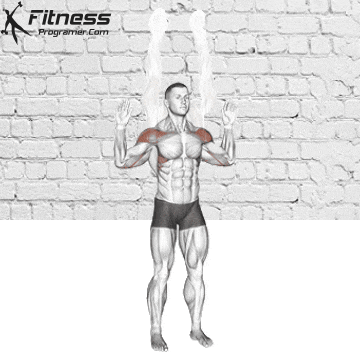
Target Muscles: Anterior Deltoid, Supraspinatus, Trapezius, Lateral Deltoid, Levatos Scapula
How to do: Stand with your back against a wall, arms bent at 90 degrees and hands at shoulder level. Slowly slide your arms up the wall, keeping your elbows and wrists in contact with the wall. Pause, then slowly lower your arms back down. Repeat for 2-3 sets of 10-15 repetitions.
4- Cable External Rotation
Cable external rotation is an effective exercise for strengthening the rotator cuff muscles, specifically the infraspinatus and teres minor muscles.
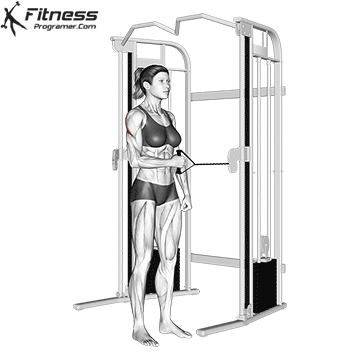
Target Muscles: Infraspinatus, Teres Minor, Posterior Deltoid
How to do: Hold a light weight (e.g. dumbbell or resistance band) in your hand and position your arm at your side with your elbow bent at a 90-degree angle. Slowly rotate your arm outward, away from your body, and then back to starting position. Repeat for 10-15 repetitions, then switch to the other arm. Perform 1-2 sets.
5- Cable Internal Rotation
Internal rotation exercises are also important for developing shoulder stability and strengthening the rotator cuff. Because there are bigger muscles devoted to internal rotation, you will be much stronger during internal rotation movements when compared to external rotation movements.
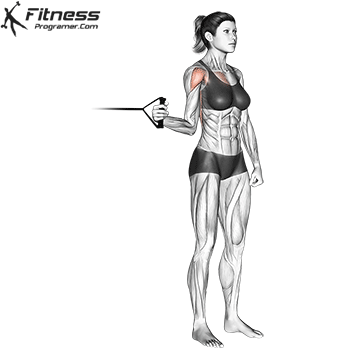
Target Muscles: Subscapularis, Teres Major, Anterior Deltoid, Latissimus Dorsi, Pectoralis Major
How to do: Hold a light weight (e.g. dumbbell or resistance band) in your hand and position your arm at your side with your elbow bent at a 90-degree angle. Slowly rotate your arm inward, toward your body, and then back to starting position. Repeat for 1-2 sets of 10-15 repetitions.
Note: Internal rotation movements compliment external rotation exercises. Include both motions to fully strengthen your rotator cuff muscles.
6- Half Kneeling Cable External Rotation
The abducted position simply means that the shoulder is out to the side and away from your body. The shoulder is less stable in this position when compared the the neutral position above. Since we have to lift and raise our arms overhead it is also important to strengthen your rotator cuff muscles in this position also.
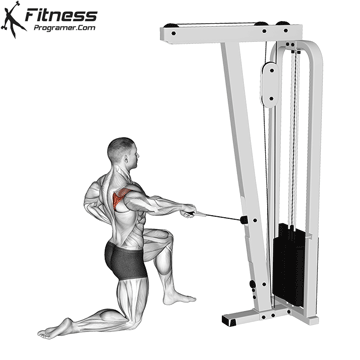
Target Muscles: Infraspinatus, Teres Minor, Posterior Deltoid
How to do: Stand on one end of the cable or resistance band, and hold your arm out to the side to about 90 degrees with your palm facing down. Exhale and rotate your shoulder so that palm is facing forwards. Hold for a brief second and then lower to the starting position.
Make sure that you keep your arm out to the side at 90 degrees throughout the movement.
Be mindful of the position of your neck and shoulder. Avoid shrugging your shoulders upwards, by keeping your shoulder blade down and backwards.
7- Band Pull Apart
The band pull apart is an exercise that targets the muscles of the upper back and shoulders, including the rotator cuff muscles.
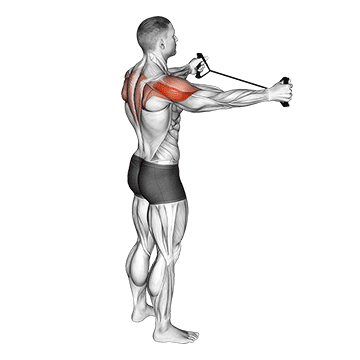
Target Muscles: Posterior Deltoid, Infraspinatus, Teres Minor, Trapezius, Rhomboids
How to do: Stand with your feet shoulder-width apart and grasp the ends of a resistance band with both hands. Keeping your arms straight, slowly pull the band apart by squeezing your shoulder blades together. Pause briefly when your arms are fully extended out to your sides. Slowly return to the starting position by bringing your arms back together in front of your chest. Repeat for 2-3 sets of 10-15 repetitions.
8- Dumbbell Standing External Rotation
External rotation is when the shoulder turns out to the side or towards the back of your body. Dumbbell External Rotation is a tricky motion to master, but it is necessary for rotator cuff strengthening.
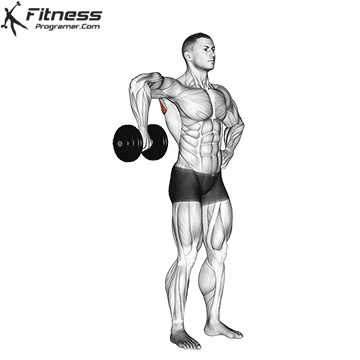
Target Muscles: Infraspinatus, Teres Minor, Posterior Deltoid
How to do: Begin by standing with dumbbells in your hands. Bring your arms out to the side at 90 degrees and have your hands facing the floor. Exhale and rotate your shoulders so that your forearms are in-line with your ears. Hold briefly and then slowly lower to the starting position. Perform 8-10 repetitions.
Move in a slow and controlled manner, and use a weight that allows you to maintain good form throughout the set.
Note: Your range of motion may be limited as you lower your arm, so don’t force it, move slowly and with control, and use a weight that allows you to stay in shape throughout the set.
9- Side Lying Dumbell Rotation
You can perform external rotation exercises from many positions, and one of the classic positions is lying on your side.
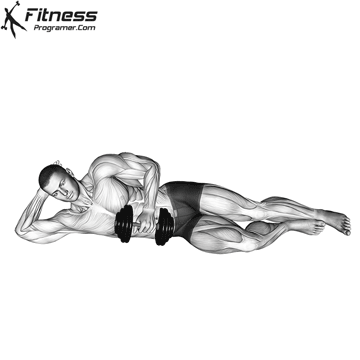
Target Muscles: Infraspinatus, Teres Minor, Posterior Deltoid
How to do: Begin by lying on your side. You can use a bench if you’re in the gym or the floor/ mat if you’re at home. Your hand and arm should be next to your body. Exhale and rotate your forearm away from your body. Hold briefly at the top and then slowly lower to the starting position.
Tips: External Rotation can be a tricky motion to master. Your upper arm should stay next to your body throughout the entire set.
Move in a slow and controlled fashion, and use a weight that you can comfortably do 8-10 repetitions with.
10- Doorway Shoulder Stretching
The doorway shoulder stretch is an effective stretching exercise for the shoulder and chest muscles that can help prevent and alleviate rotator cuff injuries. Incorporating this stretch into your daily routine can help improve your shoulder flexibility and prevent rotator cuff injuries.
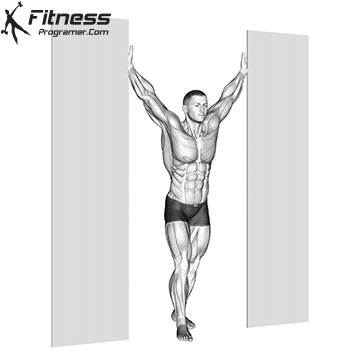
Target Muscles: Deltoids, Latissimus Dorsi, Pectoralis Major, Biceps Brachii
How to do: Lean forward slightly, feeling a stretch in your chest and shoulders. Hold the stretch for 15-30 seconds. Relax and repeat the stretch 2-3 times.
It’s important to avoid overstretching or pushing past your range of motion, as this can lead to injury.
Conclusion
In order to have a healthy shoulder joint, you must have good strength and control. So these shoulder rehab exercises are great for preventing shoulder injuries and can help some people with past shoulder injuries.
If you are healthy and have no pain but want to strengthen your rotator cuff, try some of the rotator cuff exercises on this page.
These are all sample exercises. It is best to consult with a licensed health professional if you have any injury to your shoulder or rotator cuff, before you begin any rotator cuff exercises.

